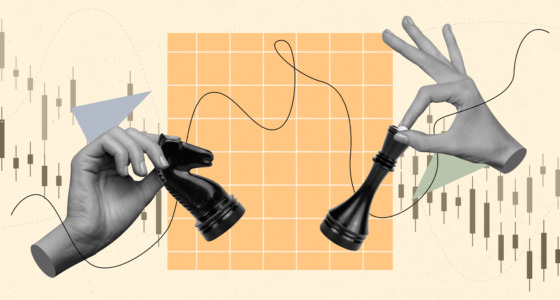

Trading can be profitable, but it comes with risks. Understanding and avoiding bear traps is crucial to prevent financial losses. A bear trap occurs when the price of a stock or asset appears to be forming a downward trend, leading traders to believe that it is an excellent time to sell the asset. However, the price suddenly reverses and rises instead of continuing to decline. In the article, we will pay special attention to recognizing and avoiding bear traps during trading.
Explanation of the Bear Trap
A bear trap occurs when an uptrend suddenly halts and a short-term downward price movement begins. This downward momentum quickly turns into a market reversal, followed by a strong rally. It can catch traders off guard.
The trap is set by institutions that deliberately push stock prices lower to generate more demand and ultimately drive prices higher. This pattern is not limited to stocks and can also be observed in bonds, currencies, cryptocurrencies, CFDs, and futures trading.
Note! A bear trap is a sudden downtrend that happens after a long-term uptrend; a quick and sharp stock rally follows it. A bear trap usually occurs in stocks with a strong trend.
How Does a Bear Trap Work?
Usually, traders recognize a bear market when stock prices or indices decline by about 20% or more over two months from an all-time high. Novice traders can easily fall into the trap of a bearish market.
Experienced traders, on the other hand, take advantage of falling prices and buy stocks. They create a scenario where buyers raise their bids to attract sellers. This increased demand creates selling pressure and disrupts the upward trend in the market. This situation is known as a bear trap.
In a bear trap, experienced traders manipulate novice stock owners into selling their assets at lower prices. They create a false impression of a worsening market condition, making novice traders panic.
Low-volume trading is a clear indicator of a bear trap. Mature investors take advantage of this trap by buying and selling assets from inexperienced traders when the market turns bullish. Trapping amateurs becomes a profitable opportunity for them.
Example
On August 6, 2019, an activist short-selling operator Bonitas Research, tweeted misleading information about Rural Funds Group, an agricultural investment firm, accusing it of fraud. This caused a significant drop of up to 42% in the prices of Rural Funds’ stocks and led to panic among long-term shareholders. In response, some shareholders sold some of their holdings, fearing the decline was legitimate.
However, Rural Funds won its case against Bonitas Research in the New South Wales Supreme Court. As a result, the company’s share prices recovered and reached new highs, but unfortunately, its shareholders suffered significant losses due to the deception.
How to Avoid a Bear Trap?
A bearish market is not always bad. Traders, especially amateur ones, can avoid being trapped in several ways.
Do Not Short Sell
Short selling is risky in trading and can result in significant losses. It should be avoided during bear traps. If you still want to sell short, you should use a stop-loss order to limit the loss on their position.
Analyze the Trend
A bear trap is a trade pattern that shows a sudden temporary downward trend. This pattern often scares novice traders, making them believe that the downtrend will continue. In response, they start selling short positions, expecting the asset values to decline further.
However, the market often turns around, surprising these traders. To prevent falling into this trap, traders use technical analysis and various trading tools. These tools include market indicators, Fibonacci retracements, volume indicators, and more. By predicting the bear trap, novice traders can avoid getting caught in these situations.
Make Smart Investments
Amateur traders should invest in small proportions or stocks of big companies with a history of successfully sustaining challenging market conditions. They have a higher chance of surviving a decline, even if the downtrend continues for an extended period. Investing in these assets can help avoid falling into a trap.
Take the Opportunity
During a bearish market, asset values decline over an extended period. This presents an opportunity for investors to purchase stocks at lower prices and build their holdings in the stock market. By owning a maximum number of assets, traders can trade them later.

Frequently Asked Questions (FAQs)
To finally understand what a bear trap is in trading, check out the answers below to the most popular questions of novice traders.
What Is a Bear Trap?
A bear trap occurs when a trade pattern falsely suggests a long-term downtrend after an uptrend. However, the market quickly reverses and creates a trap for short-sellers. It happens because there is an imbalance between selling and buying pressure, with buying pressure being stronger.
Why Is It Termed As a “Trap”?
Some institutions manipulate stock prices to create a false impression of a long-term downtrend. This leads novice traders to panic and sell short at a lower price. As a result, they fall into a trap set by experienced traders.
What Is the Difference Between a Bull trap and a Bear trap?
As we found out, a bear trap is a false reversal of an uptrend. It can confuse novice traders into selling at lower prices.
A bull trap is a trading pattern that indicates a temporary and sudden reversal of a decline in the value of a stock in the market.
The Bottom Line
A bear trap in trading refers to a deceptive market situation where there is a false signal of a downward trend reversal, causing traders to take positions that align with a bearish market sentiment. However, instead of the expected decline, the market suddenly reverses and moves in the opposite direction, trapping those who bet on the downward trend. This can lead to significant losses. It highlights the importance of thorough analysis, risk management, and staying vigilant in the ever-changing world of trading.








